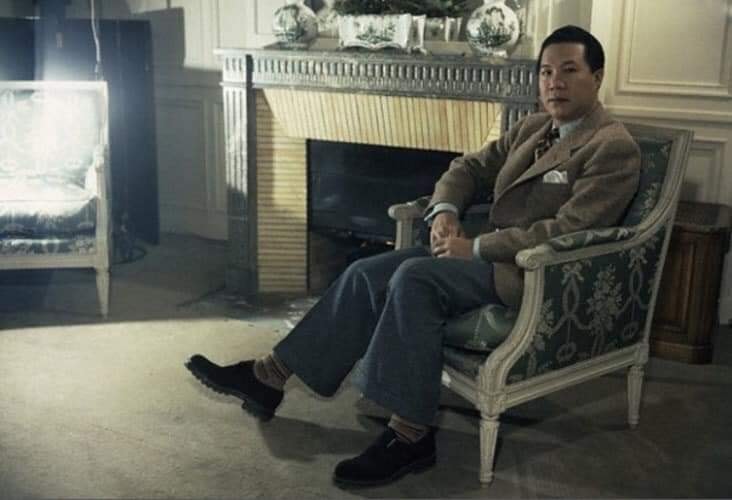The King Bao Dai Mansion, situated in the heart of Hanoi, boasts opulent classic French architecture and offers a glimpse into the regal lifestyle. This hidden gem is a must-visit for those in search of sophistication and elegance.
| Bao Dai, the last King of Vietnam was in his Ngoc Ha mansion in Hanoi. Documentary Photo. |
King Bao Dai (1913-1997) was the final ruler of the Nguyen Dynasty (1802-1945), the last imperial dynasty of Vietnam. Known for his opulent taste, King Bao Dai possessed an impressive collection of luxurious mansions, spanning from the northern to the southern regions of the country. Each of these estates possesses its own unique charm and narrative, captivating a multitude of visitors.
One of the constructions completed in Hanoi in 1911, coinciding with the inauguration of the renowned Hanoi Opera House.
The mansion is discreetly nestled on No.186 Ngoc Ha Street, Ba Dinh District, an esteemed central district in Hanoi. Its elegant presence may be overshadowed by the towering modern buildings and lush foliage surrounding it.
Created by the esteemed French architect, Arthur Kruze, known for their extensive portfolio of renowned architectural wonders both in France and across the globe, this impressive mansion boasts a one-of-a-kind design that seamlessly blends elements of Eastern and Western styles.
| The mansion from outside. Photo courstesy: Ho Hoang Hai. |
The mansion is a prestigious complex consisting of five luxurious villas. The construction materials used were primarily imported from Europe, adding a touch of elegance and sophistication. A unique feature found within the complex is the presence of bricks adorned with intricately carved French letters, adding to the overall charm and uniqueness of the property.
The facade of the building showcases a distinctive Oriental design, incorporating the iconic upward curved roof and intricate dragon and phoenix motifs. These royal symbols have historically been reserved exclusively for use by kings and signify power and prestige.
| Ngoc Ha mansion has an elegant look. Photo: Ho Hoang Hai. |
The property boasts a stunning garden spanning over 300 square meters, complete with a picturesque pond, exquisite bonsai trees, and an enchanting dragon-shaped fence reminiscent of traditional palatial gardens.
The interior architecture of the mansion is designed in Western style. The flooring and stairs are beautifully paved with wood, and the doors and windows are equipped with sliding mechanisms.
Living Room
The living room features a stylish fireplace, creating a cozy ambiance for relaxation and gatherings.
The cabinets are seamlessly integrated into the walls, providing a sleek and clutter-free aesthetic.
The electrical wiring is expertly concealed within the walls, ensuring a safe and visually appealing space.
Additionally, the living room boasts a water pump made in France, which continues to deliver reliable performance.
| The mansion’s lush green garden. Photo: Ho Hoang Hai. |
In addition, each floor is outfitted with contemporary flush toilets—an unusual feature for the country during the early 20th century. At that time, squat toilets were deemed unsanitary and were typically constructed as separate structures from the main residence. It was only around 20 years ago that flush toilets began to gain popularity.
The property boasts modern amenities including a state-of-the-art elevator designed to seamlessly transport food from the kitchen to the dining room on the second floor, creating a delightful dining experience reminiscent of a upscale restaurant. Additionally, the villa features a convenient garage located in the basement, reflecting the traditional features found in iconic French villas.
At present, the establishment houses a number of exquisite furnishings, including elegant wooden tables and chairs, as well as artworks depicting the historic streets of Hanoi and young women adorned in traditional Ao dai attire from the early 1900s. These elements serve to showcase the opulent lifestyle once enjoyed by the king.
| The mansion luxurious interior. Photo: Ho Hoang Hai. |
The establishment has been standing for over a century and remains remarkably well-preserved, with the only noticeable imperfection being a minor issue with its wall. Its location is conveniently situated just a few steps away from Huu Tiep Lake, a significant site that was targeted during the war by US bombings.
King Bao Dai, the sole Vietnamese monarch to have pursued higher education overseas, possessed a deep appreciation for Western culture. Following a decade of study in France, he returned to his native Vietnam, infused with the ideals and concepts of the West. Of particular note was his fervent passion for European architecture, which led to the construction of multiple remarkable residences throughout the country.
| Yellow walls and green windows are typical characteristics of French colonial architecture in Vietnam. Photo: Ho Hoang Hai. |
King Bao Dai is renowned for his opulent estates, with seven notable houses bearing his name. These illustrious residences showcase a striking blend of modern Western architectural styles and extravagant amenities, providing a lavish retreat for both the King and the Queen to indulge in leisurely pursuits.
The collection of his magnificent residences boasts a variety of exquisite properties. Among them is a luxurious villa in Haiphong, located in the Northern city. This villa showcases stunning French architecture with its octagonal design and offers a breathtaking panoramic view of the city from its elevated position, 40 meters above ground. Additionally, there are three elegant palaces nestled in the enchanting pine forests and hills of Da Lat, situated in the Central Highlands. The White Villa, perched gracefully overlooking a pristine beach in Vung Tau, is yet another gem in his portfolio. Also, a magnificent mansion, designed in the style of French colonial architecture, can be found in the coastal city of Nha Trang. Lastly, an impressive Palace awaits in the heart of Buon Ma Thuot, located in the Central Highlands.










